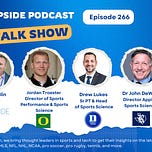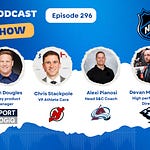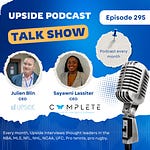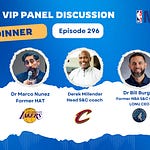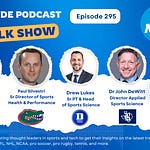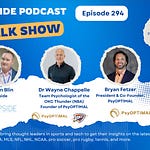This week we had the honor to interview a group of NCAA sports performance experts.
Dr. John DeWitt, director of applied sports science in the athletic department and a faculty member, Rice University (NCAA team).
Drew Lukes, Senior PT at Duke University and the head of sports science, Duke university’s women soccer team (NCAA team).
Jordan Troester, PhD, Director of sports performance and sports science at the University of Oregon (UO), a top NCAA organization.
You can watch the video interview below by clicking on the Youtube link. You can also listen to the audio interview by clicking on the link at the top of the page:
Here are some of the best quotes of our conversation with them:
Q1. NIL Impact on Athlete Behavior, Stress, and Wellness Programming
Jordan Troester:
“We’re now about three years into the NIL era, and the shift has been significant. At first, the changes were cosmetic—you noticed the jewelry, the designer clothes, and the upgraded cars in the parking lot. But over time, it’s become much more than surface-level. Athletes are starting to see themselves as brands and entrepreneurs, and with that comes new expectations. They’re becoming more discerning about the resources available to them, both internally and externally. They now walk into our performance environment not just as students or athletes, but as business entities who might have a private trainer, an agent, or a sponsorship. This shift has pushed us to rethink our service delivery model. They’re no longer just recipients of care—they’re stakeholders who expect transparency, optionality, and personalized support. We’re moving into an era where athletes are curating their own development paths. That adds complexity, stress, and a need for better communication, not only with them but across all the support staff. The next 12 months will be critical in understanding what the future of NIL, revenue sharing, and collegiate athletic identity will look like.”
John DeWitt:
“To me, what NIL has done is fundamentally changed how athletes interact with institutional systems, especially in health and medical care. We’re already seeing situations where an athlete gets hurt at ‘State University’ and decides to get surgery at an outside facility, let’s say ‘Hospital B’. But then what happens with the rehabilitation? Does the hospital handle it, or is it now the responsibility of the university again? And what if that athlete transfers mid-rehab to another institution? These are very real challenges that blur the lines of responsibility and care. It used to be that we had a fairly linear system—injury, treatment, rehab, return. Now, that process may involve multiple external parties, and the decisions are influenced by business interests, personal branding goals, or private advisors. That changes how we deliver care and increases the administrative and logistical stress on staff. The ‘professionalization’ of collegiate athletes is creating a fragmented care model that we, quite frankly, are not yet equipped to manage efficiently. These are use cases we haven’t fully thought through, and many of us are learning and adapting in real time.”
Drew Lukes:
“What’s been most surprising for me is how NIL has completely changed the types of conversations I’m having with athletes during rehab. These are athletes in non-revenue sports—many of whom feel left out of the NIL conversation—and they’re starting to express frustration, disappointment, and even identity struggles as they see their peers benefiting financially while they feel overlooked. I’m a physical therapist. I didn’t go into this field expecting to talk about income equity or endorsement deals while rehabbing a hamstring injury. But that’s where we are. These issues are showing up in the training room, in casual conversations, and during care. And what’s tough is that I don’t always have the answers, but I still have to hold space for those feelings. It’s thrown us into uncharted territory where mental and emotional stress linked to economic disparities now directly impacts wellness and rehab outcomes. It’s clear that I—and many of us—need more education around NIL, not necessarily to negotiate deals, but to better support athletes through the emotional and logistical challenges that come with it.”
Q2. Strategies for Overuse and Non-Contact Injuries
Drew Lukes:
“I’m not sure we’ve truly nailed the basics yet. Things like sleep, nutrition, hydration, and self-care—those are still inconsistent. And until we can consistently execute those foundational habits across the board, I hesitate to jump into more complex load monitoring protocols. I’ve talked to coaching staffs about this: we can track sleep and prescribe load all we want, but if the athlete is eating once a day and sleeping five hours a night, that data loses its value. So from my point of view, at Duke, I’m still focused on helping us build a solid base before we start layering in more advanced tools.”
John DeWitt:
“At Rice, what’s evolved isn’t the data—it’s the awareness of the data. A few years ago, load monitoring was siloed. It might’ve been the responsibility of the strength coach, and that’s where it stayed. Now, I’m seeing coaches, athletic trainers, and nutritionists all asking questions about workload, fatigue, and readiness. They’re connecting dots. That’s been the biggest shift—not some breakthrough technology, but a cultural shift toward collaboration and shared responsibility. The information is more cross-functional, and that alone has made a huge impact. It’s also helped get buy-in for injury prevention strategies because now everyone sees how their area is impacted.”
Jordan Troester:
“We call it an ‘integrated high-performance team.’ It’s not a device or software that solves the injury problem—it’s getting everyone aligned on what athlete support should look like. That starts with a shared vision between the head coach, the strength staff, the athletic trainer, and the nutritionist. It even goes as far as the equipment manager and academic advisors. Are we scheduling in recovery time? Are 7 a.m. practices disrupting sleep cycles? Is the training load aligned with where we are in the competition calendar? None of that takes new tech—it takes intention, planning, and honest conversations. And no, we’re never fully there. It’s a process, but the commitment to that process is what’s most important.”
Q3. Standardizing Care Amid Private Trainers and Nutritionists
Jordan Troester:
“What’s new now is that athletes have money, and that creates new behaviors. This summer, during our football team’s off-season, we’ve had a number of players flying out of town on the weekends. Some are just vacationing, but others are meeting with private skill coaches or personal trainers. They’ll say, ‘Yeah, I’m getting some work in while I’m in L.A.’ That’s something we didn’t account for in our training load. And it’s not just the workouts—it’s the travel stress, sleep disruption, and unknown variables. They’re adding training volume that we don’t always have visibility into, and it changes how we plan our weeks. It’s not at the level yet where we’re syncing calendars with every athlete’s private coach, but it’s definitely a variable we need to be more aware of.”
Drew Lukes:
“At Duke, especially with our Olympic sports athletes, I’m seeing more families seek second and third opinions. And that’s not always a bad thing. It creates learning opportunities, and in some cases, it challenges us to be better. But it also requires humility. I have to put ego aside, get the discharge notes or post-op protocol from the outside provider, and re-integrate that athlete into our care plan. It’s no longer a linear rehab process. There are more cooks in the kitchen, and while that’s manageable, it’s also a new reality that forces us to stay nimble.”
John DeWitt:
“Having worked in the NBA, I’m used to this kind of care model. Pro athletes have teams of people working on their behalf—strength coaches, massage therapists, dietitians—and communication between parties is essential. At the college level, it’s newer, and the infrastructure isn’t quite there yet to support that kind of external collaboration. But it’s coming. And the challenge is that every case is different, so you can’t create a blanket policy. You need principles and a case-by-case mindset.”
Q4. Mental Health and Athlete Identity Beyond Sport
John DeWitt:
“Rice University recently hired an Associate AD to oversee mental health, and that’s largely in response to NCAA mandates. It’s a good step forward, but one person can’t meaningfully serve 400+ athletes. So in many ways, the role is more about coordination and system building than direct service. Beyond that, my wife—who is a psychiatrist—started a sports psychiatry program at UT’s McGovern Medical School because she saw a major gap in this space. People hear ‘mental health’ and think about sleep, mindfulness, and stress. But we’re also talking about depression, anxiety, PTSD—clinical issues that deeply affect performance. That layer is often overlooked in favor of wellness strategies. We need to shift our mindset to include clinical care as a pillar of performance, not just recovery.”
Drew Lukes:
“As a practitioner working directly with athletes on a daily basis, I’ve come to realize that supporting mental health isn’t just a part of my job—it’s inescapable. Whether you’re in the middle of a rehab session or a casual check-in, these conversations just happen. Athletes are under more pressure than ever, and many of them don’t even realize how that pressure is affecting them until it manifests physically or emotionally. I’ve had to become much more comfortable having these conversations, even though I’m not a licensed psychologist. I try to listen, validate, and then guide them to the right resources when I can. We’re definitely making strides at Duke—there are more formal mental health resources available, but there’s still a gap, especially for our non-revenue sports athletes. It’s something we’re learning to navigate together. We’re not just rehabbing injuries anymore—we’re helping athletes manage the weight of expectations, identity struggles, and future uncertainties.”
Jordan Troester:
“We’ve tried to be more intentional about how we build connection and psychological safety into the environment. It’s not just about having access to a counselor—it’s about making mental health part of our culture, not an add-on. That means adjusting training schedules to account for academic stress, communicating better with athletes about expectations, and watching for red flags during recovery. We’re also leaning more into our integrated high-performance model where everyone on staff—not just the mental health professionals—is responsible for supporting the athlete’s whole self. Athletes spend more time with performance coaches, athletic trainers, and PTs than they do with any psychologist. So if we’re not equipped to spot signs of burnout, disconnection, or distress, we’re missing opportunities. In my view, mental health is no longer a separate pillar—it has to be woven into everything we do.”
Q5. NIL Resource Gaps and Competitive Readiness
Jordan Troester:
“The performance gap between resource-rich and resource-limited schools is real. But what I find fascinating is how this forces strategic thinking. You can’t compete in everything, so where are you going to invest? At Oregon, we pour into football and basketball. But that means other programs—like women’s soccer—don’t face the same resource gaps relative to their competition. If a mid-major school says, ‘Let’s dominate in softball or women’s volleyball,’ that might be their ticket to relevance. It’s not just about revenue anymore—it’s about brand building and differentiation. Athletics is still the front porch of the university, and with higher ed facing a marketing crisis, schools need to think hard about where they invest for visibility and impact.”
John DeWitt:
“From my perspective, NIL hasn’t changed how I treat athletes. Whether it’s an NFL-bound wide receiver or the last athlete on the tennis team, I provide the same care and attention. But I understand that for the broader athletic department, there are resource allocation decisions that have to be made. That’s where the performance gap shows up—in budgets and priorities—not necessarily in the day-to-day care we provide.”
Drew Lukes:
“I don’t have a whole lot to add beyond what Jordan shared, but I will say I’d never really thought about it the way he framed it—and I found that perspective fascinating. The idea that mid-majors or smaller schools might strategically invest in emerging or non-revenue sports like women’s soccer or ultimate frisbee to carve out a competitive niche… that’s a really compelling way to reimagine what success looks like in the NIL era. I think it’ll be really fun to watch over the next few years to see how different schools respond—whether they double down on traditional revenue sports or explore alternate paths that better align with their institutional identity and resources.”
Q6. Timeframe for Tech Adoption
Jordan Troester:
“There are levels to tech adoption. The first phase—where staff know how to use it—can happen in a month or two. But full integration, where it’s central to our workflow and decision-making, takes a year minimum. For a new tool to truly shape our processes, everyone—from the coaches to the athletic trainers—needs to understand the ‘why’ behind it. What problem is it solving? What decisions will it impact? That cultural buy-in takes time.”
Drew Lukes:
“It varies. If it’s a simple tool—like a hydration tester that doesn’t upload data to the cloud—we can get it up and running in a month. But if it requires IT security approval, legal vetting, and broad implementation, it can easily take six months or more.”
John DeWitt:
“I put together a one-page game day report showing hydration and force plate data for one of our teams. Two weeks later, when I didn’t send it, the coach asked where it was. That’s quick adoption—but it only happened because I had spent a year building trust and showing value. Implementation speed isn’t just about the tool—it’s about relationships, trust, and timing.”
You may also like:
🔥Upside NCAA Group Chat with Eric Renaghan (University of Miami/NCAA), Drew Lukes (Duke University/NCAA), Dr John DeWitt (Rice University), Brandon DeSantis (James Madison University/NCAA)
This week we had the honor to interview a group of NCAA sports performance experts.

